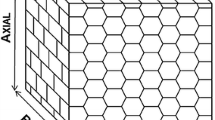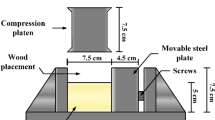Abstract
The compression properties of cork were studied on samples obtained from cork planks of two commercial quality classes (good and poor quality), with densities ranging from 0.12–0.20g cm-3 and porosities from 0.5 to 22.0%. The stress-strain curves were characterized by an elastic region up to approximately 5% strain, followed by a large plateau up to 60% strain caused by the progressive buckling of cell walls, and a steep stress increase for higher strains corresponding to cell collapse. The direction of compression was a highly significant factor of variation, with cork showing higher strength for the radial compression.
Density influenced compression and cork samples with higher density showed overall larger resistance to compression in the three directions. In the elastic region, an exponential model of Young’s modulus in function of cork density could be adjusted.
The effect of porosity on compression was small and the stress-strain curves were similar regardless of the porosity of the samples, although there was a trend toward an overall increase of stress with porosity for higher strains. Porosity was characterised by a high variability in the anatomical features of the lenticular filling material and the presence of collapsed and thick walled lignified cells. The inclusion of a porosity parameter for the modelling of the elastic modulus did not improve the prediction obtained with density-based models.
There was no significant difference in the compression properties of cork samples obtained from cork planks of good and poor quality classes.
Zusammenfassung
Untersucht wurden die Druckeigenschaften von Kork an Proben aus Material zweier handelsüblicher Qualitätsklassen (gute und schlechte Qualität), mit einer Dichte zwischen 0,12 und 0,20 g/cm3 und einer Porosität zwischen 0,5 und 22,0 %. Die Spannungs-Dehnungs-Kurven weisen bis zu ca. 5% Dehnung einen elastischen Bereich auf, gefolgt von einem großen Bereich mit 60% Dehnung aufgrund des Ausbeulens der Zellwände, und einem anschließenden steilen Spannungsanstieg bei höheren Dehnungen aufgrund von Zellkollaps. Die Druckrichtung war ein maßgebender Faktor für die Streuung der Eigenschaften. Bei radialem Druck ergab sich dabei eine höhere Festigkeit.
Die Dichte hatte einen Einfluss auf die Druckeigenschaften. Korkproben mit einer höheren Dichte wiesen eine größere Druckfestigkeit in allen drei Richtungen auf. Im elastischen Bereich konnte der E-Modul als Funktion der Korkdichte durch eine Exponentialgleichung beschrieben werden.
Der Einfluss der Porosität auf die Druckeigenschaften war gering und die Spannungs-Dehnungs-Kurven wurden durch die Porosität der Proben kaum beeinflusst. Allerdings war bei höheren Dehnungen ein Trend zu insgesamt höherer Spannung mit zunehmender Porosität erkennbar. Die Porosität zeichnet sich durch eine hohe Variabilität der anatomischen Merkmale des Füllmaterials in den Lentizellen sowie des Vorhandenseins kollabierter und dickwandiger lignifizierter Zellen aus. Ein Modell zur Beschreibung des E-Moduls in Abhängigkeit der Dichte konnte durch die Hinzunahme eines Parameters für die Porosität nicht verbessert werden.
Die Qualitätsklassen des Korkmaterials hatten keinen signifikanten Einfluss auf die Druckeigenschaften.
Similar content being viewed by others
References
Anjos O, Pina P, Rosa ME (1997) Caracterização da porosidade da cortiça amadia cozida através de análise de imagem. In Tricas FP, Vicuña YMR (eds) Proc of the I Congresso Forestal Hispano Luso, Pamplona, June 1997, p 295
Fortes MA, Nogueira MT (1989) The Poisson effect in cork. Mater Sci Eng A 122: 227–232
Gibson LJ, Easterling KE, Ashby MF (1981) The structure and mechanics of cork. Proc R Soc Lond AA 377:99–117
Gibson LJ, Ashby M, Schajer GS, Robertson CI (1982) The mechanics of two-dimensional cellular materials. Proc R Soc Lond 382:25–42
Gibson LJ, Ashby MF (eds) (1997) Cellular Solids – Structure and properties, 2nd edn. Cambridge University Press, Cambridge
Graça J, Pereira H (2004) The periderm development in Quercus suber. IAWA Bulle 25(3):325–335
Liese W, Gunzerodt H, Parameswaran N (1983) Alteraç~oes biológicas da qualidade da cortiça que afectam a sua utilização. Cortiça 541:277–299
Pereira H, Rosa ME, Fortes MA (1987) The cellular structure of cork from Quercus suber L. IAWA Bull 8(3):213–218
Pereira H (1988) Chemical-composition and variability of cork from Quercus Suber L. Wood Sci Technol 22(3):211–218
Pereira H, Graça J, Baptista C (1992) The effect of growth-rate on the structure and compressive properties of cork. IAWA Bull 13(4):389–396
Pereira H, Melo B, Pinto R (1994) Yield and quality in the production of cork stoppers. Holz Roh- Werkst 52(4):211–214
Pereira H, Lopes F, Graça J (1996) The evaluation of the quality of cork planks by image analysis. Holzforschung 50(2):111–115
Pereira H (2007) Cork: Biology, production and uses. Elsevier, Amsterdam
Rosa ME, Fortes MA (1988a) Densidade da cortiça: factores que a influenciam, Cortiça 593:65–69
Rosa ME, Fortes MA (1988b) Rate effects on the compression and recovery of dimensions of cork. J Mater Sci 23(3):879–885
Rosa ME, Pereira H, Fortes MA (1990) Effects of hot water-treatment on the structure and properties of cork. Wood Fiber Sci 22(2):149–164
Rosa ME, Fortes MA (1991) Deformation and fracture of cork in tension. J Mater Sci 26(2):341–348
Rosa ME, Pereira H (1994) Effects of long term treatment at 100–150 °C on structure, chemical composition and compression behavior of cork. Holzforschung 48(3):226–232
Soile P (eds) (1995) Morphological image analysis. Principles and applications. Springer Verlag, Berlin
Young JF, Mindess S, Gray RJ, Bentur A (eds) (1998) The Science and Technology of Civil Engineering Materials. Pearson Education
Author information
Authors and Affiliations
Corresponding author
Rights and permissions
About this article
Cite this article
Anjos, O., Pereira, H. & Rosa, M. Effect of quality, porosity and density on the compression properties of cork . Holz Roh Werkst 66, 295–301 (2008). https://doi.org/10.1007/s00107-008-0248-2
Published:
Issue Date:
DOI: https://doi.org/10.1007/s00107-008-0248-2




